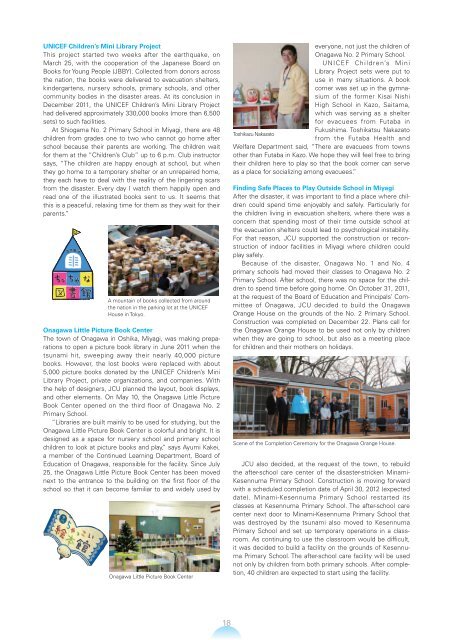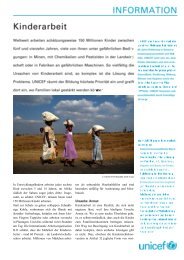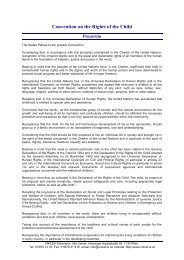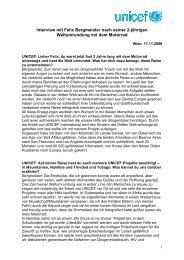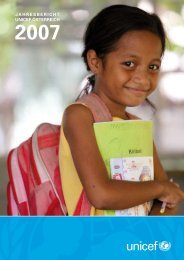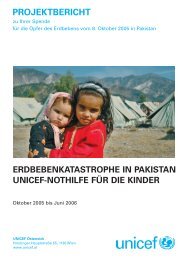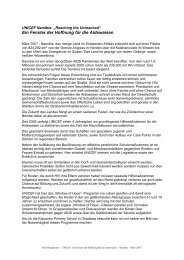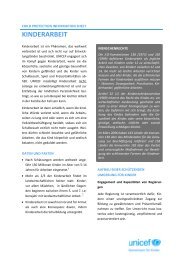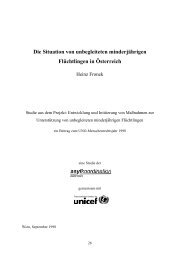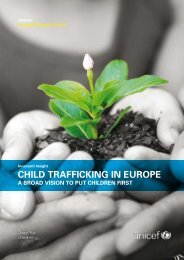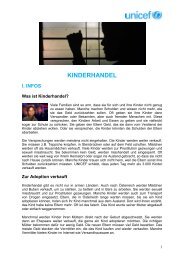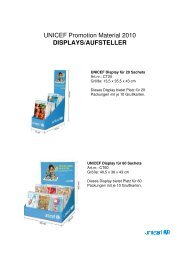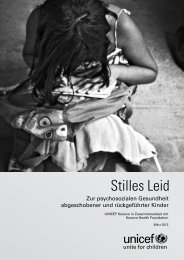You also want an ePaper? Increase the reach of your titles
YUMPU automatically turns print PDFs into web optimized ePapers that Google loves.
UNICEF Children’s Mini Library Project<br />
This project started two weeks after the earthquake, on<br />
March 25, with the cooperation of the Japanese Board on<br />
Books for Young People (JBBY). Collected from donors across<br />
the nation, the books were delivered to evacuation shelters,<br />
kindergartens, nursery schools, primary schools, and other<br />
community bodies in the disaster areas. At its conclusion in<br />
December 2011, the UNICEF Children’s Mini Library Project<br />
had delivered approximately 330,000 books (more than 6,500<br />
sets) to such facilities.<br />
At Shiogama No. 2 Primary School in Miyagi, there are 48<br />
children from grades one to two who cannot go home after<br />
school because their parents are working. The children wait<br />
for them at the “Children’s Club” up to 6 p.m. Club instructor<br />
says, “The children are happy enough at school, but when<br />
they go home to a temporary shelter or an unrepaired home,<br />
they each have to deal with the reality of the lingering scars<br />
from the disaster. Every day I watch them happily open and<br />
read one of the illustrated books sent to us. It seems that<br />
this is a peaceful, relaxing time for them as they wait for their<br />
parents.”<br />
A mountain of books collected from around<br />
the nation in the parking lot at the UNICEF<br />
House in Tokyo.<br />
Onagawa Little Picture Book Center<br />
The town of Onagawa in Oshika, Miyagi, was making preparations<br />
to open a picture book library in June 2011 when the<br />
tsunami hit, sweeping away their nearly 40,000 picture<br />
books. However, the lost books were replaced with about<br />
5,000 picture books donated by the UNICEF Children’s Mini<br />
Library Project, private organizations, and companies. With<br />
the help of designers, JCU planned the layout, book displays,<br />
and other elements. On May 10, the Onagawa Little Picture<br />
Book Center opened on the third floor of Onagawa No. 2<br />
Primary School.<br />
“Libraries are built mainly to be used for studying, but the<br />
Onagawa Little Picture Book Center is colorful and bright. It is<br />
designed as a space for nursery school and primary school<br />
children to look at picture books and play,” says Ayumi Kakei,<br />
a member of the Continued Learning Department, Board of<br />
Education of Onagawa, responsible for the facility. Since July<br />
25, the Onagawa Little Picture Book Center has been moved<br />
next to the entrance to the building on the first floor of the<br />
school so that it can become familiar to and widely used by<br />
Onagawa Little Picture Book Center<br />
18<br />
everyone, not just the children of<br />
Onagawa No. 2 Primary School.<br />
UNICEF Children’s Mini<br />
Library Project sets were put to<br />
use in many situations. A book<br />
corner was set up in the gymnasium<br />
of the former Kisai Nishi<br />
High School in Kazo, Saitama,<br />
which was serving as a shelter<br />
for evacuees from Futaba in<br />
Fukushima. Toshikatsu Nakazato<br />
Toshikazu Nakazato<br />
from the Futaba Health and<br />
Welfare Department said, “There are evacuees from towns<br />
other than Futaba in Kazo. We hope they will feel free to bring<br />
their children here to play so that the book corner can serve<br />
as a place for socializing among evacuees.”<br />
Finding Safe Places to Play Outside School in Miyagi<br />
After the disaster, it was important to find a place where children<br />
could spend time enjoyably and safely. Particularly for<br />
the children living in evacuation shelters, where there was a<br />
concern that spending most of their time outside school at<br />
the evacuation shelters could lead to psychological instability.<br />
For that reason, JCU supported the construction or reconstruction<br />
of indoor facilities in Miyagi where children could<br />
play safely.<br />
Because of the disaster, Onagawa No. 1 and No. 4<br />
primary schools had moved their classes to Onagawa No. 2<br />
Primary School. After school, there was no space for the children<br />
to spend time before going home. On October 31, 2011,<br />
at the request of the Board of Education and Principals’ Committee<br />
of Onagawa, JCU decided to build the Onagawa<br />
Orange House on the grounds of the No. 2 Primary School.<br />
Construction was completed on December 22. Plans call for<br />
the Onagawa Orange House to be used not only by children<br />
when they are going to school, but also as a meeting place<br />
for children and their mothers on holidays.<br />
Scene of the Completion Ceremony for the Onagawa Orange House.<br />
JCU also decided, at the request of the town, to rebuild<br />
the after-school care center of the disaster-stricken Minami-<br />
Kesennuma Primary School. Construction is moving forward<br />
with a scheduled completion date of April 30, 2012 (expected<br />
date). Minami-Kesennuma Primary School restarted its<br />
classes at Kesennuma Primary School. The after-school care<br />
center next door to Minami-Kesennuma Primary School that<br />
was destroyed by the tsunami also moved to Kesennuma<br />
Primary School and set up temporary operations in a classroom.<br />
As continuing to use the classroom would be difficult,<br />
it was decided to build a facility on the grounds of Kesennuma<br />
Primary School. The after-school care facility will be used<br />
not only by children from both primary schools. After completion,<br />
40 children are expected to start using the facility.


